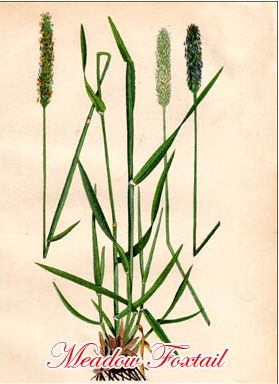Mountain Rose Ranch
208-347-2741 in the Heartland of Idaho
Mountain Rose Ranch Products
Mountain Rose Ranch is at 4000 feet elevation with one cutting per year. We strive to produce quality hay rather than quantity, and we continue to practice natural methods to provide for sustainability and productivity.
The fields were orignially planted with Meadow Foxtail (Alopecurus pratensis*scroll down for specific description) by the Circle C Ranch, one of the largest cattle ranches in the Heartland. We do aerate the fields in the fall, to stimulate growth and productivity by breaking up the clump grasses. We harvest for the quality and palatability by early cutting with minimal drying and immediate stack and cover.
"The 'as pure as nature can do' farm, properly speaking, is not one that uses certain methods and substances and avoids others; it is a farm whose structure is formed in imitation of the structure of a natural system that has the integrity, the independence and the benign dependence of an organism.”
Wendell Berry,
Call now to reserve for 2018
208-347-2741
Alopecurus pratensis
Meadow Foxtail is a cool-season perennial sod-grass. It was introduced to this continent from Europe and Asia.
LIFE CYCLE
Meadow foxtail growth begins in early spring and continues throughout the season until the first hard freeze.
FLOWERING PARTS
The seed head is very dense, narrow panicle that looks like a spike. The spikelets are flattened, hairy along the edges, and have one floret each. Each floret has a very small bent awn. The seed head is 2 to 4 inches long.
VEGETATIVE PARTS
The bunch grass has loosely bound shoots that give it an almost sod-grass appearance. Leaves are flat and relatively pale green in color. The stems from 1 to 3 feet tall.
DISTRUBUTION AND HABITAT
Meadow Foxtail, as the name implies, grows in wet meadows and moist upland sites. It is cold tolerant and has been planted in mountain meadows and spring and summer pastures. It can also be grown under irrigation for hay and pasture forage.
INTERESTING FACTS
Foxtail is good forage for livestock and grazing wildlife, especially before it matures. It makes good hay, and is often planted with a legume, like alfalfa, in pastures. It is planted for soil stabilization on ditches and steam banks. Meadow foxtail can also provide cover for nesting birds.
LOOK ALIKES AND IDENTIFICATION TIP
Meadow foxtail looks similar to timothy grass and grows in similar moist habitats. To differentiate them, check the florets. Timothy has two awns in each spikelet (resembling ears or horns). Foxtail has one bent awn extending from the middle of each floret.
SHORT VERSION OF FACTS:
Characteristics—non-native perennial, naturalized from Europe, bunchgrass with short rhizomes
• Longevity—10+ years
• Palatability for livestock—high when very
young, low most of the year
• Yield—moderate
• Fertility needs—moderate to high
• Site adaptation—moist to moderate
• Shade tolerance—low
• Toxicities—none known
• Uses—forage production (pasture and hay)
• Seedling establishment—slow
• Seedling vigor—low to moderate
• Average number of seeds per pound—500,000
• Other—very cold tolerant




